When I joined the law enforcement fraternity in 1977, it was a revolver world for police. With very rare exceptions, state and local coppers carried double action revolvers; most of those were chambered for 38 Special and most were made by Smith & Wesson.
Part of the reason many agencies avoided the autoloader was complexity in the manual of arms – gun handling. I recall the “jammatic” complaints, but administrators were likely concerned about accidents and “leaving the safety on” creating unnecessary injuries and deaths.
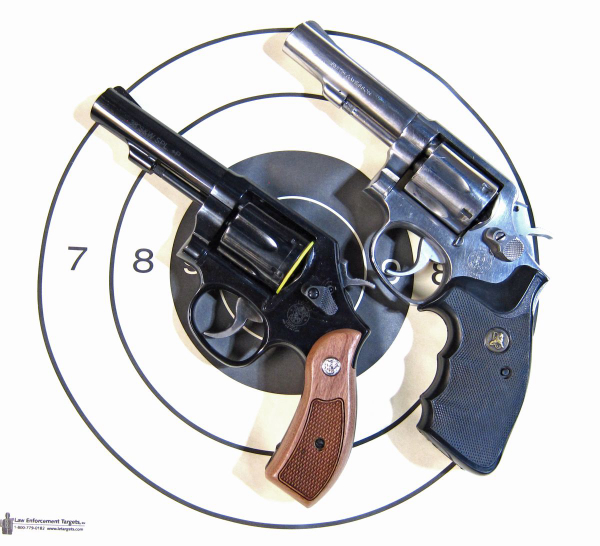
The revolver was simple; swing the cylinder out, drop rounds into the chambers. If they fit, close the cylinder into the frame. To shoot, pull the trigger. When it no longer makes loud noises, swing the cylinder out, dump the empties and refill the chambers. Close and repeat.
Were there accidents with revolvers? Well, yes. Were some cops outgunned?
Seldom – if they could shoot.
For the new gun owner, you can get a snub but many say they’re harder to shoot accurately. The heavier trigger with the coil-spring action and the shorter sight radius – plus less gun to hang onto – is indeed a problem for duffers.
But what about full-size 38 revolvers? There’s enough gun to hold, the sight radius is longer, the action can more easily be tuned – especially if the mainspring is a flat spring.
Who makes such a gun? Smith & Wesson, with their Model 10 (formerly “Military & Police” … sound familiar?)
The current M10 has a four-inch bull barrel, easier to hold on target as you work through the double action trigger. It has fixed sights that are unlikely to be knocked out of line by accident. The current K-frame, of which the Model 10 is one, has a round butt, more easily accommodating smaller hands.
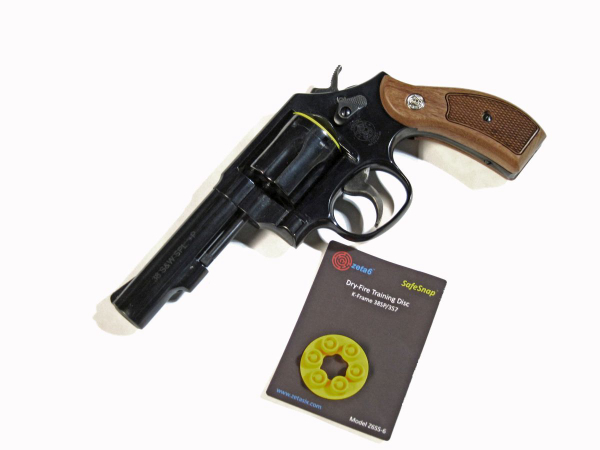
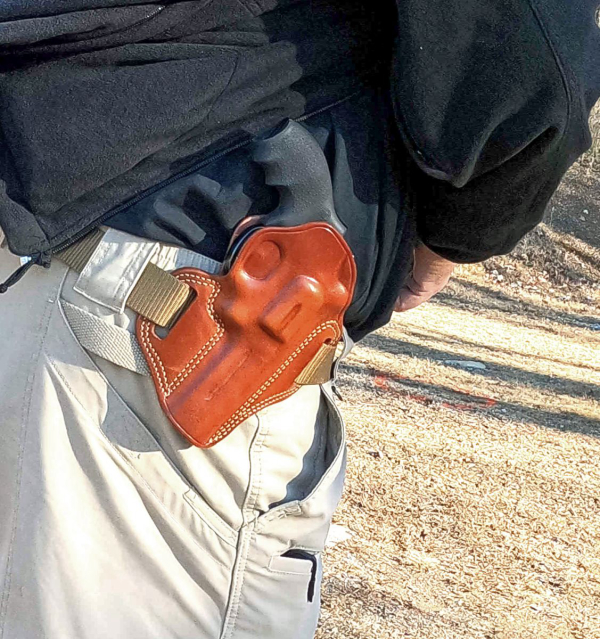
The 38 Special won’t beat a new shooter to death, but has sufficient penetration to make it appropriate for defense use.
Accuracy? As far as the cartridge goes, it (along with the 45 ACP) was a standard match round for nearly a century. Used in the National Matches for the Centerfire stages, the 38 Special was wonderfully developed for accuracy. It’s one of the first centerfire rounds developed for self-defense use. Not many cartridges can match it for longevity in the space.
Consider safety: to check the piece, keep the muzzle in the safest available direction and look at the gun from the side. If you see brass at the back of the cylinder, there are rounds in there; they could be fired but may not be. Swing the cylinder out and look into the chambers; run your finger over the back of the cylinder; you’ll feel the case heads if any are in there – even in the dark.
An asset to safe handling and practice is the SafeSnap from Zeta6. A ring that fits into the chambers of the revolver cylinder, it has a center plastic plug to absorb energy from firing pin impact – and minimizing wear from dry practice (which is essential). It also serves as a “safety” flag, indicating that the revolver has no live rounds in the (already occupied) cylinder.
Don’t cock the gun by drawing back the hammer – until you know how to safely lower the hammer.
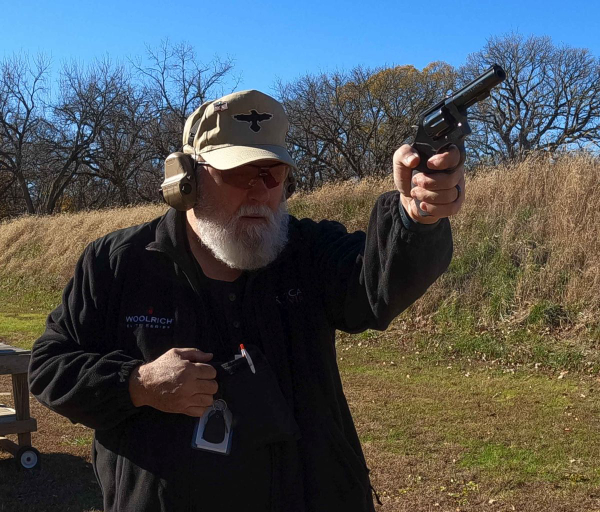
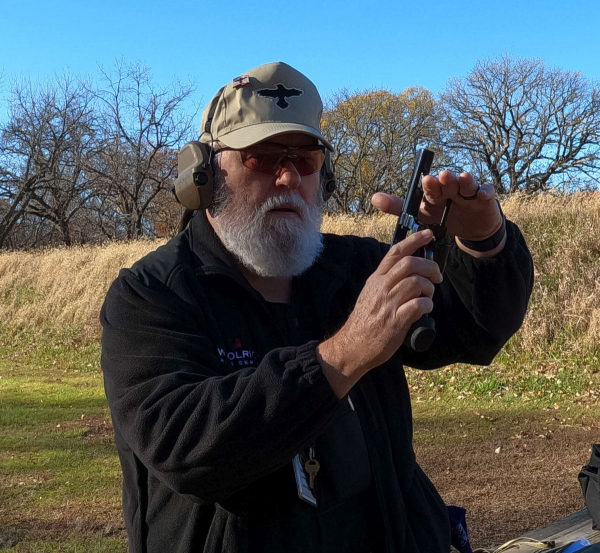
As to stocks (“grip” is something one does), wood looks good. Rubber shoots and handles better. The “Magna-“ like lumber on the new M10; it’s pretty and I imagine getting a grip adapter to fill in the space behind the trigger guard would do. Still, I have an affinity for the Hogue stocks generally and the Bantam in particular.
Allowing a handful of stock without having a rear flare to spoil concealment, the Hogue Bantam 62000 has an open backstrap – good for the small handed – and palm swells – to aid in comfort of those with larger hands. Being able to reach the trigger face with the distal joint (the “power crease,” identified by Mas Ayoob) is aided by the open backstrap. As to the bare backstrap thumping your hand with heavy loads, this is a nearly-35-ounce revolver and it’s chambered for 38 Special. I think you’ll be fine.
I changed the stocks before firing a round – I’ve been shooting double action S&W revolvers since about 1973 – and added the Galco Combat Master belt holster. I don’t like leaving guns lying around unattended. If it’s out of lock-up, I’m wearing it and a high ride outside the waist holster is as good a way as any.
So equipped, I collected an assortment of ammo and went to the range.
I began with checking the 10-yard zero with the new M&P revolver while checking velocity with the Garmin Xero Pro C1 chronograph. Low-cost (and available during the last ammo drought) TUL Ammo 130 grain FMJ – not marked “+P” – nevertheless charted +P velocity, averaging 1,070 feet-per-second. It felt every bit of it. The load hit 3 ½” low, putting five pills into 2 ¾”. The best three, surprisingly, went into 5/8”.
That’s not 25 yards, but it’s not shooting from a seated bench rest supported position. It’s closer, but fired two-hands standing without support – double action.
Old stock Federal Hydrashok 129gr. +P ammo gave an average of 892 fps. It hit an inch low on the bull, putting five bullets into 2 ¾”. The best four rounds went into 1 3/8”.
Hornady Critical Defense “Lite” 90 grain FTX was indeed light. The 964 fps average speed was fine, the load hit 2 ½” under the sights and had a five-shot 2 3/8” group. The best three were in 1 3/8”.
Some old stock Winchester 130 grain SXT +P ammo averaged 898 fps and put five hits into 2 ¼”, a nice effort. The best three were in 1 ¾”. The load was nearly dead-on, the group center being only 7/8” low.
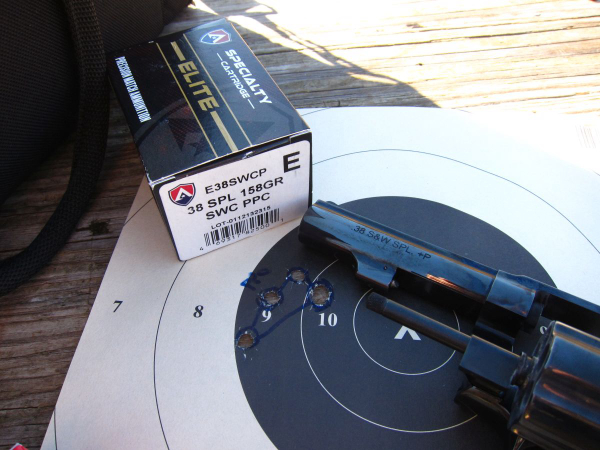
Finally, Atlanta Arms/Specialty Cartridge Elite 158 gr. Semi-wadcutter “PPC” ammo (E38SPL158SWCBX) had an average velocity of 662 fps. Before crying over that, consider five hits into 1 ½” with the best three in ½”. It hit at zero for elevation in the M10 too.
Georgia Arms Ultimate Defense 148gr. wadcutter put three hits into an inch, at zero for elevation and it broke 800 fps in the four-inch barrel. That’s plenty for penetration.
That’s a good trade-off.
|
S&W M10-14 |
Avg vel |
Spread |
|
Tul Ammo 130 FMJ |
1069.6 |
131.7 |
|
Federal Hydrashok 129gr +P |
892.1 |
41 |
|
Hornady Critical Defense "LITE" 90gr |
964.2 |
50 |
|
Winchester SXT 130gr. +P |
898.3 |
57 |
|
Atlanta Arms/Spec. Ctg. SWC PPC |
662 |
36 |
|
Georgia Arms Ultimate Defense WC |
818 |
43 |
I posted a Birchwood Casey “Shadow Target,” a reduced size variation of the NRA TQ-19 silhouette – the target is 12x18”. Using up more of that TUL Ammo 130 grain FMJ, I did some drills from the holster and from ready, one-handed and two-, pairs, failures to stop and sustained fire.
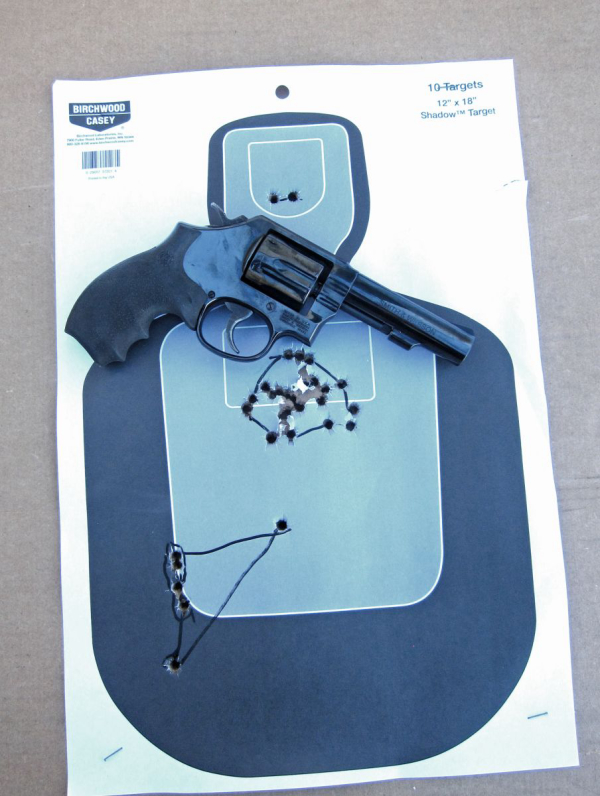
The only time I wandered close to the edge of the pint-size silhouette was six rounds from 25 yards. Not allowing for the fact that the TUL load hit low at ten yards, it went lower at 25. I contributed a flyer out of the main scoring zone but still on the target.
The Model 10-14 is fully capable. Remember there was a time that uniformed police wore a similar gun in a majority of US police agencies. The FBI issued the M&P/Model 10 with a four-inch skinny barrel.
It seems like they did okay with it.
For new gun owners wanting a home defense piece that’s portable and easy to use, the S&W M10 brings advantages.
— Rich Grassi